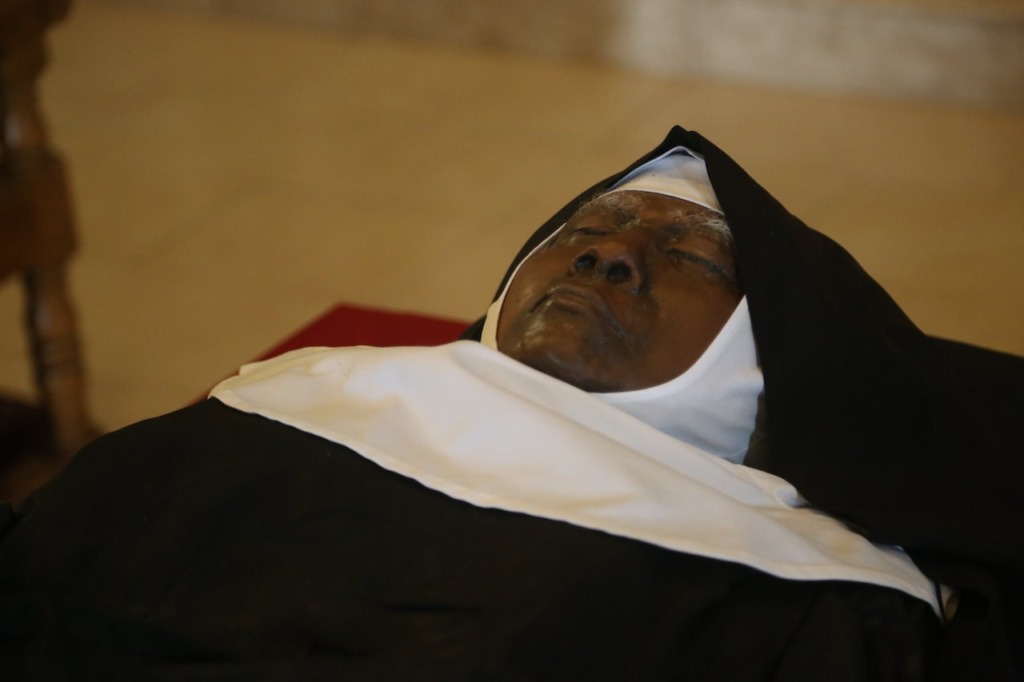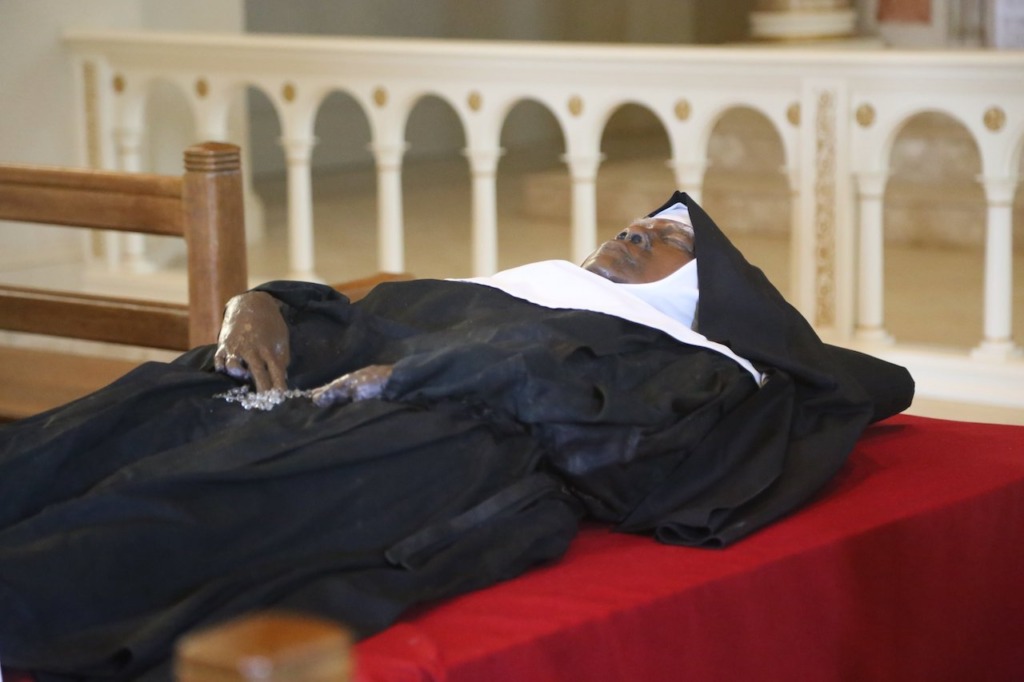(OSV News) – A community of contemplative Benedictine sisters in rural Missouri is preparing for as many as 10,000 pilgrims to flock to their monastery to view and pray before the body of their foundress, whose recently exhumed body is claimed to be incorrupt.
Foundress of the Benedictine Sisters of Mary, Queen of the Apostles, in Gower, Missouri, Sister Wilhelmina Lancaster of the Most Holy Rosary died in May 2019 at age 95. On April 28, her body was exhumed from her grave to move it to a tomb in the monastery’s chapel. Despite her body not being embalmed, damage to her wooden coffin, and water sitting on her grave – all elements that should have contributed to her body’s decomposition – her body was found remarkably intact, the community’s sisters say.
The sisters laid their foundress’ body in the main chapel and protected her skin with wax. As word spread, Catholics from the region and then around the country began to flock to see her. The sisters have been allowing visitors to press holy items against Sister Wilhelmina’s body to create relics should the foundress ever formally be declared a saint.
Father Matthew Bartulica, the sisters’ chaplain, told OSV News May 26 that they expect thousands of visitors to arrive at the monastery to view her remains. On May 26, pilgrims at the Abbey of Our Lady of Ephesus reported via Twitter that the wait to see Sister Wilhelmina was two hours long.
“It’s the kind of thing you read about and you don’t think will happen to you, but that’s something that I think has struck a lot of people, especially those who knew her,” Sister Scholastica Radel, the community’s prioress, told OSV News May 22.
The sisters’ website notes that visitors should be prepared to wait in line and bring folding chairs and umbrellas for shade. Guests are welcome at the abbey from 8 a.m.-8 p.m. daily. The sisters plan to place their foundress’ remains in a glass shrine May 29. “Please note that you will still be able to see Sister’s body and touch relics of her habit and take dirt from her grave after the morning of the 29th,” the website states.

A May 22 statement from the Diocese of Kansas City-St. Joseph said the condition of Sister Wilhelmina’s remains “has understandably generated widespread interest and raised important questions. At the same time, it is important to protect the integrity of the mortal remains of Sister Wilhelmina to allow for a thorough investigation.”
“Bishop (James V.) Johnston is working to establish a thorough process for understanding the nature of the condition of Sister Wilhelmina’s remains,” it continued. “Incorruptibility has been verified in the past, but it is very rare. There is a well-established process to pursue the cause for sainthood, but that has not been initiated in this case yet. Bishop Johnston invites all the Faithful to continue praying during this time of investigation for God’s will in the lives of the Benedictines of Mary, Queen of Apostles; for all women religious; and all the baptized in our common vocation to holiness, with hope and trust in the Lord.”
Incorruptibility has long been regarded as a divine sign of sanctity in both Catholic and Orthodox tradition, and the bodies of more than 100 canonized saints have been seemingly untouched by decay.
Sister Wilhelmina established the Benedictine Sisters of Mary, Queen of the Apostles in 1995, following 50 years as a member of the Oblate Sisters of Providence in Baltimore, a historically African American religious community whose foundress, Mother Mary Elizabeth Lange, is on the path to sainthood.
In 2006, the community moved from Scranton, Ohio, to a rural area in the Diocese of Kansas City-St. Joseph in 2006 at the invitation of Bishop Robert W. Finn. In 2019, the community established its first daughter house in Ava, Missouri. The sisters worship in Latin using the form of the Mass promulgated prior to the Second Vatican Council and chant the psalms using the 1962 Monastic Office.
Because it is customary in many places for a religious community’s foundress to be buried in its main chapel, the sisters exhumed Sister Wilhelmina’s remains with plans to place them in an altar dedicated to St. Joseph behind the main altar. They were advised that they would likely find bones, Sister Scholastica said.
All of the community’s sisters had been present at Sister Wilhelmina’s death, “and it was such a holy death that you could almost tangibly feel the presence of Our Lord in the room,” Sister Scholastica said. “So with that holy death, all of us having witnessed that, we kind of had a suspicion, but you didn’t want to be presumptuous either, because it’s such a rare grace to have an incorruptible.”
Just as they had dug their foundress’ grave four years earlier by hand, they again dug her grave by hand to exhume her coffin. They were surprised to find that the top of the coffin had collapsed in, presumably from the burial. The community’s abbess shone a flashlight through a crack near the foot of the coffin. The abbess screamed, Sister Scholastica recalled, and said, “I didn’t just see that” and then said, “It’s her foot!”
“All the sisters screamed at that point, we couldn’t hold it in,” the prioress said. “And so (the abbess) gave me the flashlight to look in too, because I’m the prioress and second in command, and sure enough, you looked in the crack and there was her foot, and it was completely full with the sock. I mean, you could even see the Hanes tag on the sock. It was that full and complete. And so she said, “If that’s her foot, what’s the rest of her?’”
It became apparent to the sisters that their foundress was not just bones. “There was kind of a mold mask covering her entire face and a part of her hands, but we could still see the hands gripping the rosary, and the fingernails were there and her crucifix was there,” Sister Scholastica said. “And even the flowers that she was holding had dried in her hand. So that’s when we started to realize, OK, there’s something very, very odd happening here.”
The fabric that had lined the coffin had disintegrated, but Sister Wilhelmina’s habit was in perfect condition, “in better shape than most of ours,” the prioress said.
“And what was even more remarkable is we lifted the cuculla, which is kind of an outward covering that we wear especially for vespers, and you could even see the cut marks that we had made on the day of her burial to fit it around her,” Sister Scholastica told OSV News. “And when we lifted that edge of the material, there were even threads that were still hanging down from where we had cut. So it was that untouched. And it was all natural fibers, so it should absolutely be gone. She had a synthetic veil, which was very similar to that material that we use for the lining – that also was completely intact; no holes, none of it was threadbare. It was in beautiful condition.”
The sisters walked the coffin back to their convent, singing hymns, and then in their parlor, some sisters gently cleaned the body. Once exposed to air, “the skin got drier, but nevertheless it was all still there,” Sister Scholastica said. “All of her features were there. I mean she had hair on her face, the eyebrows were there, the eyelashes were there, her nose, her mouth – her mouth was even curved up in a smile, so you could see a little bit of the tooth underneath.”
As they moved Sister Wilhelmina’s body, they could feel her joints move, the prioress said.
“The takeaway of it all, why God permits all this, it’s to renew our faith in the resurrection of the dead, and that there are certain souls that he loves very much and he leaves them this way in order to prove that truth to those who do hope in him,” Sister Scholastica said. “There is this promise of eternal life, and not only eternal life, but in our body as well. And I think that’s probably the main message that Sister Wilhelmina was trying to get through to us.”
If devotion to Sister Wilhelmina becomes well established, the sisters will support opening a cause into their foundress’ sainthood, Sister Scholastica said. “It has to be that the holiness is recognized outside of just our little sphere here. So I think that’s kind of what’s happening now. Because we have had hundreds of people I mean, every day now. … On a usual day, we will often have no visitors at all.”
Even if Sister Wilhelmina is never named a saint, “we still have this witness that God is with us and that he still wants to grant us these graces,” Sister Scholastica said. “It’s been just a really, I think, amazing experience, something totally unexpected.”
Sister Scholastica was one of the first sisters to join the community Sister Wilhelmina founded, she said. Their foundress “was the rock of the community and always so edifying and cheerful, and such a prayerful woman. But her joy really stood out a lot,” she said.
“Our first chaplain once asked her, ‘Why did you become a nun?’ And without skipping a beat, she answered, ‘Because I was in love with the Lord.’ And I think that really sums up her life altogether: just that she was in love with our Lord, and he was her joy,” she said.
Editor’s note: Read more about Sister Wilhelmina and her impact on Black Catholic heritage.

